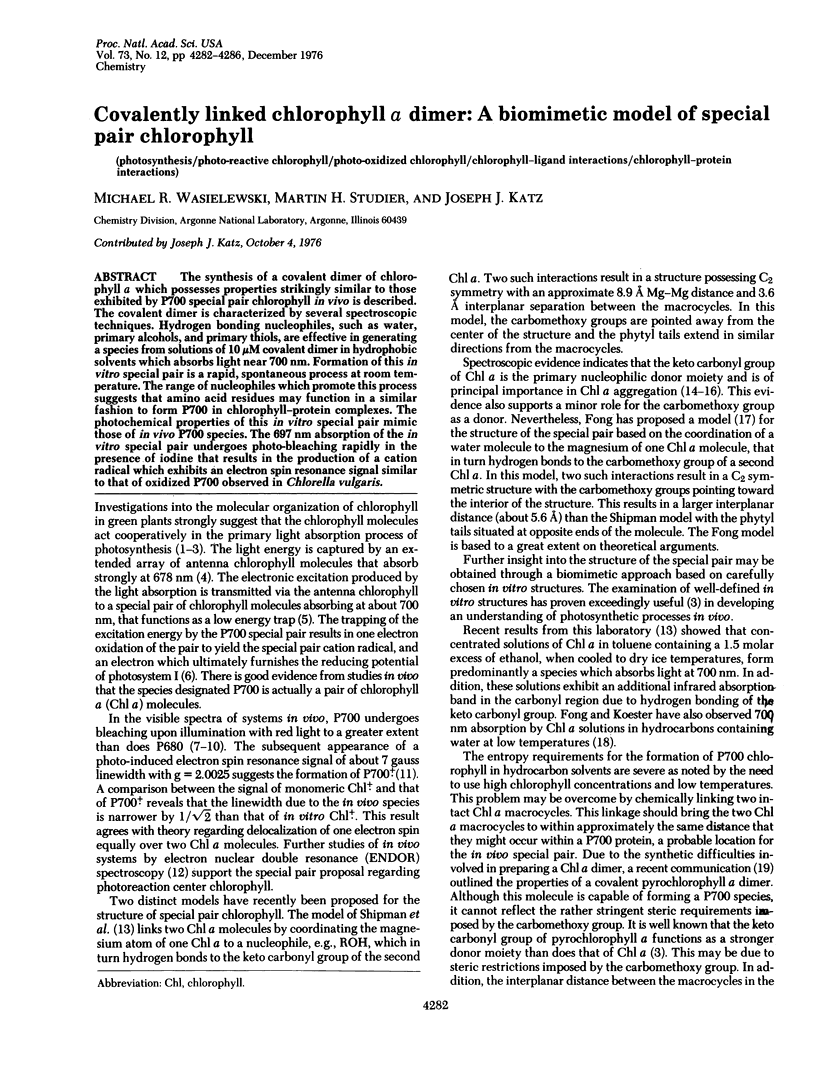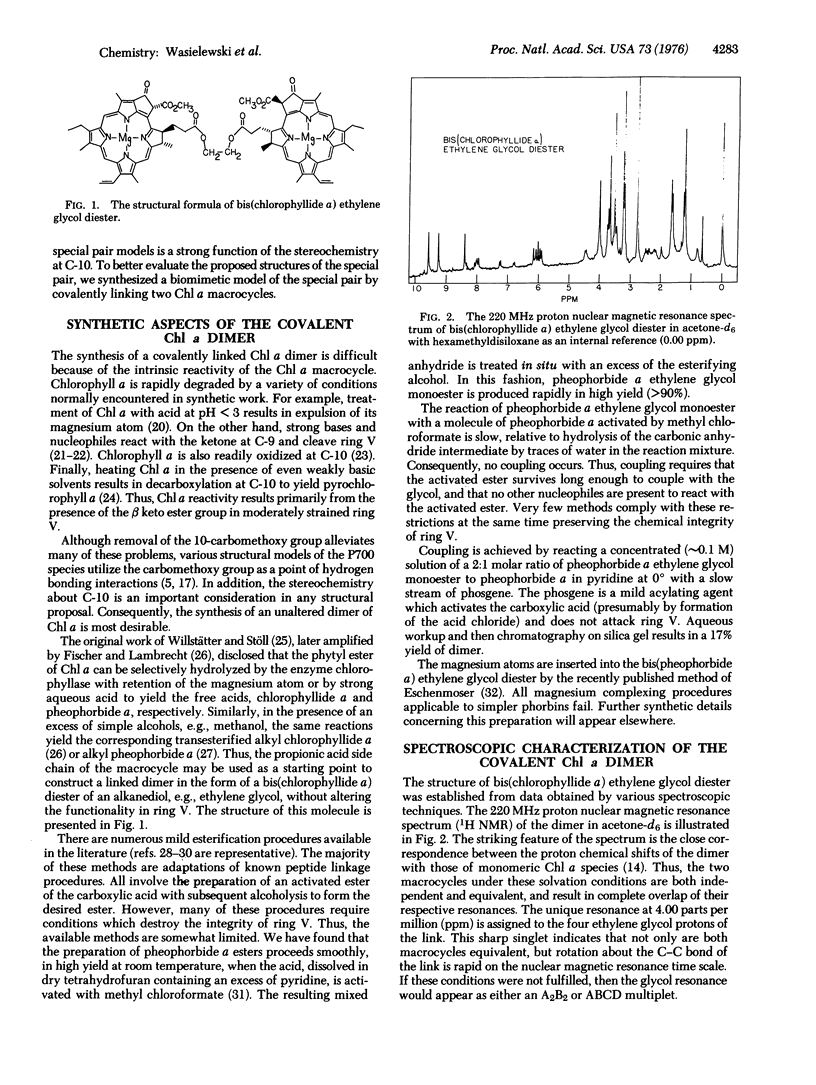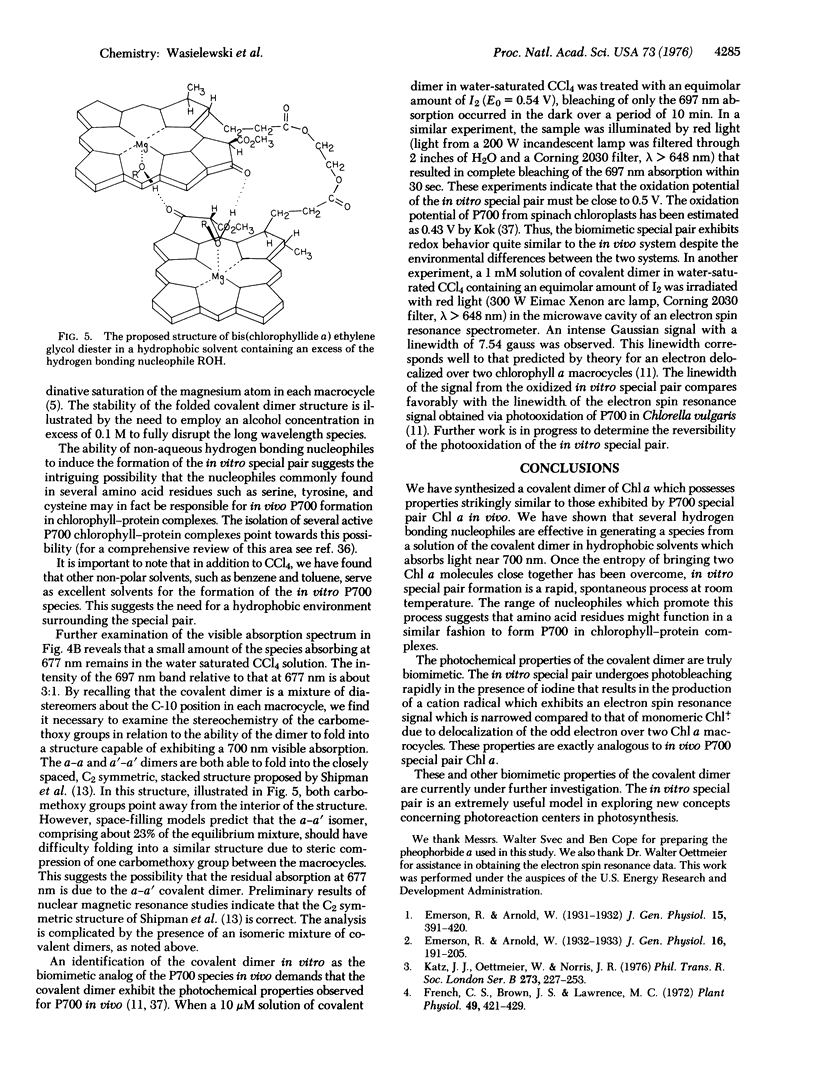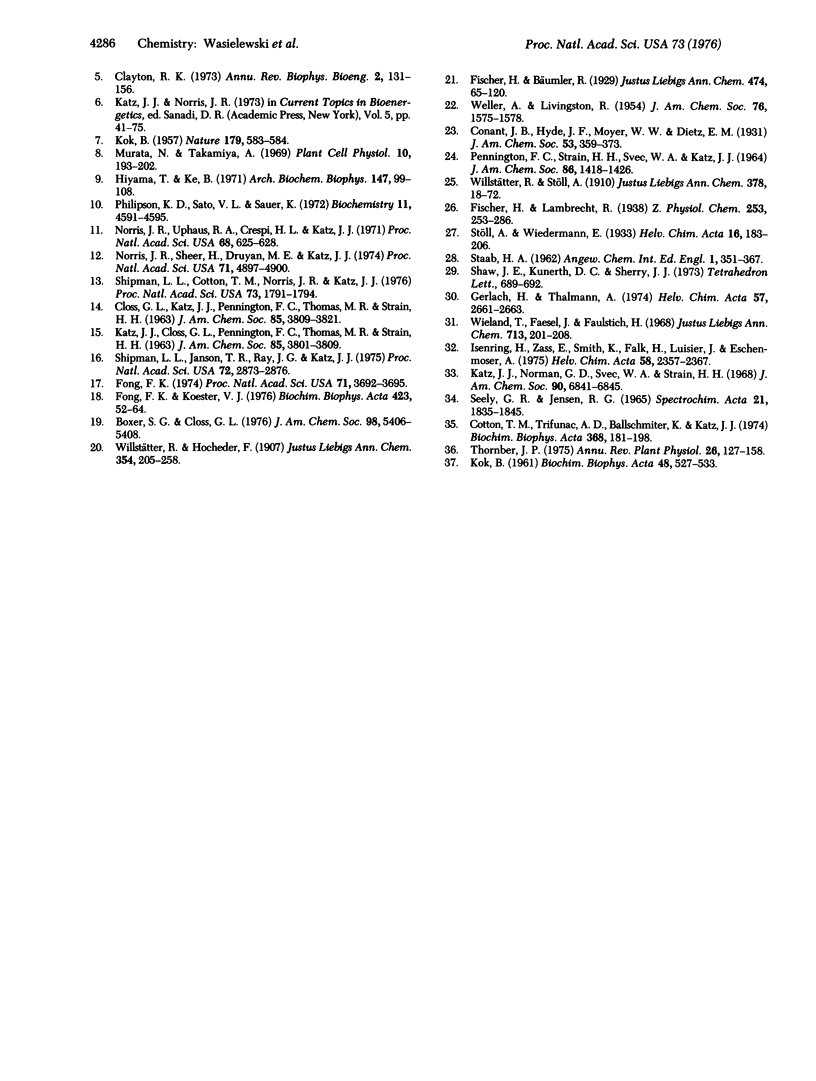Abstract
The synthesis of a covalent dimer of chlorophyll a which possesses properties strikingly similar to those exhibited by P700 special pair chlorophyll in vivo is described. The covalent dimer is characterized by several spectroscopic techniques. Hydrogen bonding nucleophiles, such as water, primary alcohols, and primary thiols, are effective in generating a species from solutions of 10 μM covalent dimer in hydrophobic solvents which absorbs light near 700 nm. Formation of this in vitro special pair is a rapid, spontaneous process at room temperature. The range of nucleophiles which promote this process suggests that amino acid residues may function in a similar fashion to form P700 in chlorophyll-protein complexes. The photochemical properties of this in vitro special pair mimic those of in vivo P700 species. The 697 nm absorption of the in vitro special pair undergoes photo-bleaching rapidly in the presence of iodine that results in the production of a cation radical which exhibits an electron spin resonance signal similar to that of oxidized P700 observed in Chlorella vulgaris.
Keywords: photosynthesis, photo-reactive chlorophyll, photo-oxidized chlorophyll, chlorophyll-ligand interactions, chlorophyll-protein interactions
Full text
PDF




Selected References
These references are in PubMed. This may not be the complete list of references from this article.
- Clayton R. K. Primary processes in bacterial photosynthesis. Annu Rev Biophys Bioeng. 1973;2:131–156. doi: 10.1146/annurev.bb.02.060173.001023. [DOI] [PubMed] [Google Scholar]
- Cotton T. M., Trifunac A. D., Ballschmiter K., Katz J. J. State of chlorophyll a in vitro and in vivo from electronic transition spectra, and the nature of antenna chlorophyll. Biochim Biophys Acta. 1974 Nov 19;368(2):181–198. doi: 10.1016/0005-2728(74)90148-0. [DOI] [PubMed] [Google Scholar]
- Fong F. K., Koester V. J. In vitro preparation and characterization of a 700 nm absorbing chlorophyll-water adduct according to the proposed primary molecular unit in photosynthesis. Biochim Biophys Acta. 1976 Jan 15;423(1):52–64. doi: 10.1016/0005-2728(76)90100-6. [DOI] [PubMed] [Google Scholar]
- Fong F. K. Molecular basis for the photosynthetic primary process. Proc Natl Acad Sci U S A. 1974 Sep;71(9):3692–3695. doi: 10.1073/pnas.71.9.3692. [DOI] [PMC free article] [PubMed] [Google Scholar]
- French C. S., Brown J. S., Lawrence M. C. Four universal forms of chlorophyll a. Plant Physiol. 1972 Mar;49(3):421–429. doi: 10.1104/pp.49.3.421. [DOI] [PMC free article] [PubMed] [Google Scholar]
- Hiyama T., Ke B. A further study of P430: a possible primary electron acceptor of photosystem I. Arch Biochem Biophys. 1971 Nov;147(1):99–108. doi: 10.1016/0003-9861(71)90314-6. [DOI] [PubMed] [Google Scholar]
- KOK B. Partial purification and determination of oxidation reduction potential of the photosynthetic chlorophyll complex absorbing at 700 millimicrons. Biochim Biophys Acta. 1961 Apr 15;48:527–533. doi: 10.1016/0006-3002(61)90050-6. [DOI] [PubMed] [Google Scholar]
- Norris J. R., Scheer H., Druyan M. E., Katz J. J. An electron-nuclear double resonance (ENDOR) study of the special pair model for photo-reactive chlorophyll in photosynthesis. Proc Natl Acad Sci U S A. 1974 Dec;71(12):4897–4900. doi: 10.1073/pnas.71.12.4897. [DOI] [PMC free article] [PubMed] [Google Scholar]
- Norris J. R., Uphaus R. A., Crespi H. L., Katz J. J. Electron spin resonance of chlorophyll and the origin of signal I in photosynthesis. Proc Natl Acad Sci U S A. 1971 Mar;68(3):625–628. doi: 10.1073/pnas.68.3.625. [DOI] [PMC free article] [PubMed] [Google Scholar]
- Philipson K. D., Sato V. L., Sauer K. Exciton interaction in the photosystem I reaction center from spinach chloroplasts. Absorption and circular dichroism difference spectra. Biochemistry. 1972 Nov 21;11(24):4591–4595. doi: 10.1021/bi00774a027. [DOI] [PubMed] [Google Scholar]
- Shipman L. L., Cotton T. M., Norris J. R., Katz J. J. New proposal for structure of special-pair chlorophyll. Proc Natl Acad Sci U S A. 1976 Jun;73(6):1791–1794. doi: 10.1073/pnas.73.6.1791. [DOI] [PMC free article] [PubMed] [Google Scholar]
- Shipman L. L., Janson T. R., Ray G. J., Katz J. J. Donor properties of the three carbonyl groups of chlorophyll a: ab initio calculations and 13C magnetic resonance studies. Proc Natl Acad Sci U S A. 1975 Aug;72(8):2873–2876. doi: 10.1073/pnas.72.8.2873. [DOI] [PMC free article] [PubMed] [Google Scholar]
- Wieland T., Faesel J., Faulstich H. Uber Peptidsynthesen. Cyclisierung mit einer verbesserten Anhydrid-Methode. Justus Liebigs Ann Chem. 1968;713:201–208. doi: 10.1002/jlac.19687130125. [DOI] [PubMed] [Google Scholar]


